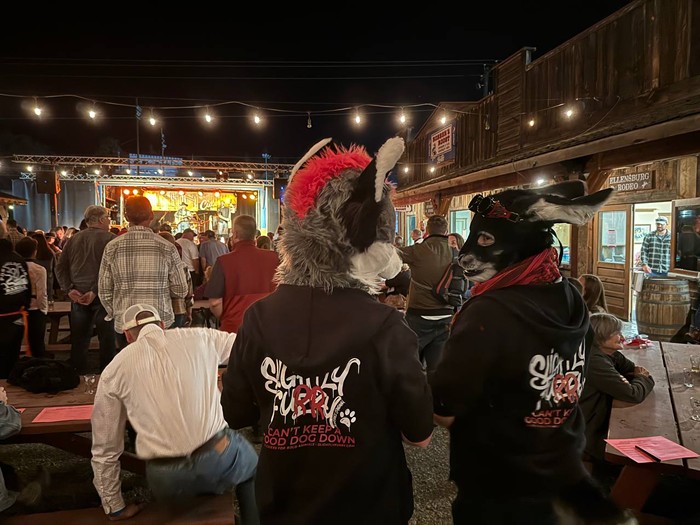The next time it rains, I'm going to make haste to Kushibar, drink a lot of beer, and have (at least) the following snacks: tako yaki, shin gyoza, gochamaze, gyu tataki, grilled sanma. I will bring a few friends, and we will sit in the simple but somewhat magical indoor-outdoor part of Kushibar, a sort of glassed-in sidewalk-seating area, except the glass is plastic. (In nicer weather, it can convert to open-air.) If you ever had a Habitrail and wished you could get inside it, this part of Kushibar will be very, very pleasing to you. (Please also note that the word "Kushibar" is limitlessly pleasing to say.)
The view through the plastic is of Second Avenue and, in the back, down onto a parking lot—a vista that at first seems poor but as you sit begins to seem correct in its random urbanness. When it's raining, the rain will fall on the ceiling overhead (also transparent) and rivulet down the sides. The Kushibar people will turn on the heat lamps. It will sound like being on a boat in the rain, and it will still smell like the indoor-outdoor area's ribs of new wood, its fresh wooden picnic-type tables. If prior experience is any indicator, tablesful of Asian boys will peck at their laptops, and tablesful of Asian girls will giggle and take multiple group photographs, switching off photographers between shots. Everyone will be eating Japanese street-food snacks that would cost approximately one-third as much on an actual Japanese street, and everyone will be happy about it.
It's also fun to sit at the counter inside Kushibar proper, where you can watch the chefs grilling the kushiyaki—the skewers of vegetables, of beef, of fish and shellfish, of chicken and chicken hearts and gizzards and livers, of unspecified cartilage (upon availability)—on a long, narrow grill right in front of you. It's filled with glowing Bincho-tan, a special Japanese white charcoal. Overhead, the largest oven hood known to humanity vacuums the smoke away, creating loud but soothing white noise. One evening recently, a little girl sat alone for some time there, wearing miniature patent wedge heels with a design of a guitar with wings on the outside of each foot. With her choice seating, her poise, and her footwear, she was obviously the smartest, calmest, and most stylish person in the place.
She proved to be the offspring of chef Billy Beach, he of the blue chef's jacket, bleach-tipped hair, and om necklace. Beach has an aspect of Miami about him, but if you stop and shout your compliments across the counter, he's down to earth, willing to entertain questions, and completely nice. He also runs Umi Sake House a block or so away, a super-stylish place that serves big, complicated sushi rolls and pan-Asian small plates; people like Umi, but it's nothing special. Kushibar is stylish, too—the long, narrow, very high-ceilinged space is a mirror image of Tavolàta next door, with matching exposed concrete and contemporary spareness—and you're paying for it, to be sure. A Japanese friend describes the stands where you find kushi in its homeland—called yakitori, after their primary product—as "really shitty." Sometimes there are beer boxes instead of tables, and the wood panels along one wall at Kushibar are a grand imitation of the tattered paper menus hung up at the street-side dives overseas. (The last one says "arigato.")
So you're eating Japanese street food at Belltown indoor prices—you can still try a lot of things for not a lot of cash. The $10 minimum per-person specified on the menu indicates how cheaply you could snack here, with skewers all $2 or $3 each—tender shiitake mushroom, not-too-sweetly glazed dark-meat chicken, not-too-chewy chicken heart, diced beef or beef tongue, peppery scallop, or a prawn. They hit the spot in their small-quantity ways more than they miss the mark. (In the miss category, one mushroom skewer was oversalted, and the lone prawn seems just too paltry and was a bit dry.) In the seafood column, I'm still anxious after a couple visits to try yellowtail, unagi, and capelin, which is a tiny smelt. (The menu, in too-small font and poorly adhered to a block of wood on each table, is massive.)
But it's the unskewered snacks that are most exciting: tako yaki ($5), those deliciously squishy dough-balls with a piece of elasticky octopus at the center, are house-made and exceptionally good. Shin gyoza ($5), pork pot stickers done "street style," are flatter than usual, providing bonus crispy-fried wrapper-surface area, with the wrappers being thin and delicate, and the filling just right. Gochamaze means, approximately, "all mixed up"; it's a salad of mixed greens dressed with garlic oil and ginger vinegar, topped with a generous amount of daily-changing meats and seafood—maybe super-thin-sliced beef and octopus and chunks of fresh tuna and so forth. At $8, it's one of the higher-priced items and also a steal. Gyu tataki ($6) is barely seared beef tataki, vinegary and gingery and pretty much perfect. Grilled sanma for $6 seems like a gift: a long, skinny pike mackerel, grilled whole until flakey and served beautifully on a long, skinny white dish. And I forgot the ika teppo ($6), rounds of grill-flavored, snappy squid stuffed with soft salmon and a cross-section of crunchy asparagus stalk at the center. To this I say YAY.
Kushibar's specialty cocktails look promising, and a cucumber daiquiri ($9) was quite good, but this food begs for beer. A pitcher of Sapporo here ($14, or $11 at happy hour) is very much worth leaving work early for, especially on a rainy, dark day. ![]()



















